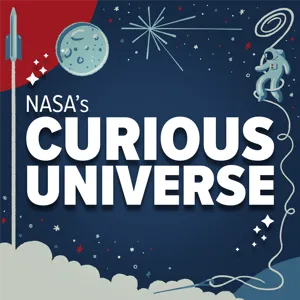Podcast Summary
Exploring new ways to make air travel more efficient and accessible: NASA's aeronautics division is working on developing electric-powered flying vehicles for short-distance transportation, potentially revolutionizing city connectivity
Curiosity and the desire to understand the world around us can lead to incredible advancements in technology, as exemplified by the evolution of transportation from horses and wagons to airplanes, and now potentially to flying cars. NASA, through its aeronautics division, is at the forefront of this innovation, exploring new ways to make air travel more efficient and accessible. Shivangali Sharma, a NASA aerospace research engineer, is working on the Advanced Air Mobility Project, which aims to develop and test electric-powered flying vehicles that can take off and land vertically, potentially revolutionizing short-distance transportation. While the exact form of this new mode of aviation is still uncertain, it holds the promise of making cities more connected and enabling us to explore our surroundings more easily. This curiosity-driven pursuit of knowledge and innovation is a hallmark of NASA's mission to explore the wild and wonderful universe.
Revolutionizing transportation with advanced air mobility: NASA is focusing on infrastructure, safety, and airspace systems for eVTOL aircraft, which could lead to personal, goods, and emergency services transportation innovations
Advanced air mobility, or AAM, which includes the use of electric vertical takeoff and landing (eVTOL) aircraft, has the potential to revolutionize transportation by offering new options for personal and goods travel, as well as emergency services. NASA is focusing on the infrastructure and safety aspects of AAM, including the development of landing pads, sensors, and automation for vertiports, and the evolution of airspace systems to accommodate these new aircraft. The benefits of AAM extend beyond individual transportation, as it could also lead to more efficient goods transportation and improved emergency medical and fire services. However, ensuring safety in the skies will require new regulations and technologies, such as those being developed by NASA and the FAA. Imagine a future where you can call a flying taxi to take you to your destination, or where goods are delivered to you more quickly and efficiently than ever before. AAM has the potential to make this future a reality.
Designing safe and organized flying systems for autonomous vehicles: Collaboration between airspace management and vehicle operation is essential for the integration of autonomous flying vehicles into our transportation system. Extensive testing and research are necessary to make this future a reality, with a focus on innovation and learning from trial and error.
The integration of autonomous flying vehicles into our transportation system is a complex process that involves not only the development of new technology but also the reimagining and collaboration between airspace management and vehicle operation. This is a significant shift from the traditional one-axis approach of aviation, where either flight or airspace management was focused on separately. David and his team are working on designing systems to ensure safe and organized flying, drawing parallels from our current road systems. Mike Gaminsky, the Advanced Air Mobility project manager, envisions the use of these vehicles as a new form of public transportation, akin to a subway system. However, to make this future a reality, extensive testing and research are necessary, as we learn and adapt to the challenges and limitations of this new technology. Innovation and a willingness to learn from trial and error are crucial in turning our imaginations into a tangible reality.
Teamwork and continuous learning in NASA's aeronautics research: NASA's complex projects require teamwork and unique perspectives from engineers, programmers, pilots, and human factors experts. Continuous learning and iteration, using the scientific method and 'fly, fix, fly' approach, are essential for success.
Teamwork and continuous learning are essential components of NASA's aeronautics research. NASA's projects are too complex for an individual to handle alone, making teamwork crucial. The team consists of engineers, programmers, pilots, and individuals focused on human factors. Each member brings unique perspectives and expertise to find solutions. Continuous learning and iteration are also essential. NASA uses the "fly, fix, fly" approach, where they learn from every flight and apply those lessons to the next one. The scientific method, which involves forming a hypothesis, conducting experiments, and iterating based on the results, is the core of NASA research. NASA embraces the unknown and is always exploring new frontiers, making trial and error an inevitable part of the process. Trust but verify is another essential aspect, with multiple people cross-monitoring performance to ensure safety and success.
The importance of perseverance, trial and error, and collaboration in aerospace engineering: Numerous roles contribute to the success of aerospace industry, from pilots to engineers, with setbacks and failures leading to innovation and pushing boundaries, and opportunities for passion-driven individuals to shape the future of flight.
Testing and teamwork are crucial in the aerospace industry. While the focus may be on pilots and groundbreaking innovations, there are numerous supporting roles that contribute to the success of aeronautics. Setbacks and failures are part of the process, and they help refine ideas and push the boundaries of what's possible. NASA's Curious Universe episode highlights the importance of perseverance, trial and error, and collaboration in the field of aerospace engineering. From pilots to engineers, coaches to referees, there are various roles for individuals with different skills and passions to contribute to this exciting industry. The first recorded flight in 1903 marked a significant milestone, and the ongoing advancements in aerospace technology show that the opportunities for innovation and exploration are vast. If you're passionate about aeronautics, remember that there are numerous roles beyond the pilot seat, and your contribution can help shape the future of flight.
Microwave Landing System for Aviation, Not Mars: Microwave Landing Systems are ground-based navigational aids for aviation, not technology for Mars landings
A microwave landing system, like the one NASA studied in 1983, is a ground-based navigational aid that uses microwaves for aircraft to ping and navigate towards. It's not a system for landing on Mars using microwaves. This misconception arose during the podcast discussion, and it's important to clarify the difference. The 1983 NASA study focused on using microwaves for ground-based navigation, not for landing on Mars. The podcast may explore other topics, but this clarification is essential to avoid confusion. The microwave landing system is an interesting piece of aviation history, but it's not the technology that will enable Mars landings.






